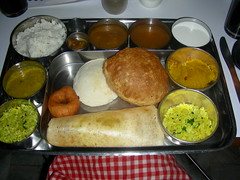Before I say anything, let me forewarn you that this is likely to be my lengthiest post yet…but it’s the weekend so you’ll have lots of time to digest, if you’re not too bored.
The time I spent recently in India delivered all the contradictions and ironies I had been promised. It’s a wonderful place to visit, and I truly enjoyed my stay there. It was the first time in ten years I’d been outside of North America or Europe, and it reminded me of just how different life can be in different corners of the globe. The number of trees I need to plant to offset my travel notwithstanding, I do think it’s important from time to time, if possible, to interact in a deeply meaningful way with another culture.
I was there for the first of my two weddings (we’re doing it again in the US this fall for all our friends and family here), and spent five weeks, mainly in Hyderabad. I don’t mean to claim that I speak about all of India, and want to just put out the disclaimer that this is just my experience and observations that I’m sharing.
I think my relationship with material things is what I’ve reflected upon most since my return. This really surprised me. I thought before I left that the poverty and unequal distribution of wealth would be most difficult for me to stomach. There certainly were days that I had tears in my eyes, when the poverty was just overwhelming. I felt like throwing up more than once (separate from the times I felt like throwing up from the three or four stomach bugs I contracted).
For some reason, however, I was really slapped in the face by how much STUFF we have in North America…and how much of it is absurdly unnecessary. I don’t know why I didn’t notice this on my past travels. I suspect it’s due to my lack of maturity at the time. For whatever reason, it’s been a very heavy weight I’ve been carrying with me ever since my return.
I believe that simple is best, so I’ll try to summarize as briefly as possible, the ironies, from a simplicity/frugality/environmental standpoint, that I witnessed.
Here’s what was not cool:
1. There is trash everywhere. Public trashcans were difficult to find or non-existent. I asked the driver of our car one day what I should do with a gum wrapper and water bottle I had, and he told me he’d take care of them. I found them later on the street in front of the house. Not quite what I meant. So I started saving my trash and throwing it out in the house. Then I realized that the man who took care of the house was burning it all every morning. Not sure that’s super healthy. There was a super smelly impromptu landfill that had sprung up about 2 miles from where we were staying. The trash that was officially collected from that side of town was being dumped here because the official landfill was too far away, and well, nobody had complained.
2. I didn’t see a single way to recycle anything the entire time I was there.
3. Air pollution is a major problem. It was often hard to breath, and I could never get my face to feel clean for more than half an hour at a time.
Here’s what was awesome:
1. Everybody eats local. There’s not really much choice. Most people still buy their produce from vendors on the side of the road, and those guys only sell what they’ve harvested recently. I’m worried that as the middle class grows, this may begin to change. Grocery stores are just starting to spring up everywhere, and the huge conglomerate is not something that only exists in North America (check out Tata or Birla). I was glad to hear my MIL say that she still goes out of her way to buy things from the local shop owner when she can because she knows it’s getting more difficult for them to make it with big corporate competition. I hope more people feel the same way.
2. Everybody eats a lot of vegetarian food. I know we’ve been hearing lots in the media about how the increased demand for meat from India and China are driving up food prices and causing grain shortages. I do not dispute the accuracy of this argument. I would stress, however, that “increased demand” doesn’t mean that Chinese and Indian folks are now eating meat three times a day. I don’t know what the case is in China, but I imagine it’s similar – increased demand means that a lot of people now eat meat once or twice a week rather than once a twice a month. A lot of people are still totally vegetarian for religious reasons. I think that if the US demand per capita for meat was equal to that of an average Indian person, we’d be patting ourselves on the back for a job well done.
3. Lots of people have electricity, but very few of them expect it to function all the time. There are frequent power outages of varying lengths, some announced, and some not. The funniest part to me, is that the conversation never skips a beat, even when the lights go out, it’s totally dark, and everybody is fumbling to find candles and matches.
4. Water is trucked in and stored in tanks. Everybody is cognizant that there is a very finite supply, and uses it much more carefully than we do in the US. Showers, for example, are taken by filling a bucket (maybe four gallons or so) and using a smaller bucket to dump the water on yourself to wash and rinse with.
5. Nobody uses toilet paper. Actually I’m not sure if this is actually awesome or not, because they use water instead, so I guess it’s a matter of “dueling resources” at this point. Either way, I wasn’t brave enough to try this method - although I probably should have, because good luck finding anything other than single ply. What is awesome is that paper towels and facial tissue are also virtually non-existent.
6. Each power outlet has an on/off switch. I’ve heard this is also the case in Australia, and probably other places as well, but it makes it really easy to ensure that appliances are really off and not sucking energy. This is important because electricity is super expensive - so much so that despite the fact that it’s hotter and muggier (at least for parts of the year) than anywhere here in North America, almost nobody has air conditioning. There are fans, and “coolers” that work by somehow circulating water through this big thing that has some hay (I’m not a real technical person, if you can’t tell) but these both use much less energy than an air conditioner. Life without AC is possible!
7. Everybody squeezes in – everywhere. Fuel is expensive, so a van for ten people will somehow manage to accommodate twelve to fifteen people for a six hour trip. There are small little vehicles called autos – sort of like giant motorized tricycles with roofs – that look like they’d comfortably seat three passengers and a driver. I’ve seen them packed with seven and more passengers. Safety concerns, I know…I’m just saying that I’ll think next time before taking a second car somewhere just so somebody doesn’t have to sit in the middle seat. Buses are another story altogether. If you’re claustrophobic, you just wouldn’t make it. People literally ride the bus with one foot on the step, holding on to the door frame, because the buses are so crowded.
8. Along with the squeezing in theme, growing up and getting married is not automatically a reason to get your own house. Again, I’m not sure I’d like to do this, but lots of people live with parents and/or in-laws.
9. Because electricity is so expensive, people make do with smaller refrigerators. Humans originally started using spices for a reason, and lots of spices in the foods help them to stay edible without refrigeration.
10. Clothes are always dried on a line. I don’t think dryers are even readily available for purchase.
11. Packaging is much more minimal. Bulk purchase of many items is the only option – you can’t buy a box of rice; it comes in a large sack or you scoop it from a bin. Leftover food in restaurants is packed in folded newsprint rather than Styrofoam containers. Nearly everything you will find for sale has little to no packaging – and almost always, there is less packaging than you’d find for the same item in North America.
12. Stuff gets reused…even when it’s not in pristine condition. I sent my laundry out one day in a bag whose handle was about to break. I figured I’d get it back in a new bag, but I got it back in that same bag – with the handle taped back on. There’s a value placed on things that seems to be lacking in North American culture.
What worries me is that the reason why we don’t do some of these things here in the US seems to be simply a matter of financially not being forced to. For example, we have clothes dryers because we have inexpensive electricity. When I stopped looking at things in terms of dollars is when I started being able to appreciate the true value of how things are done elsewhere in the world, and when I started wanting to live less like a “typical” consumer.













